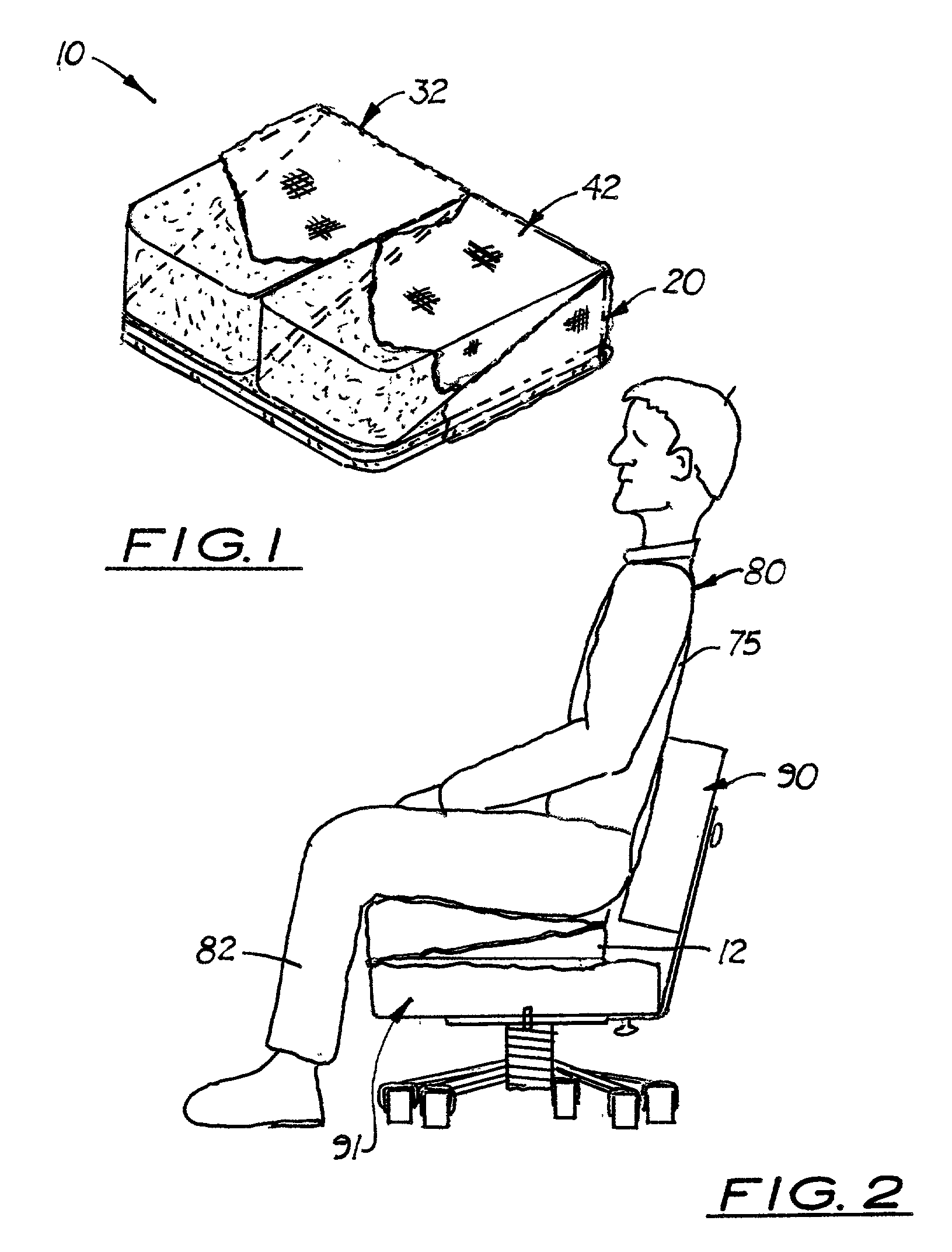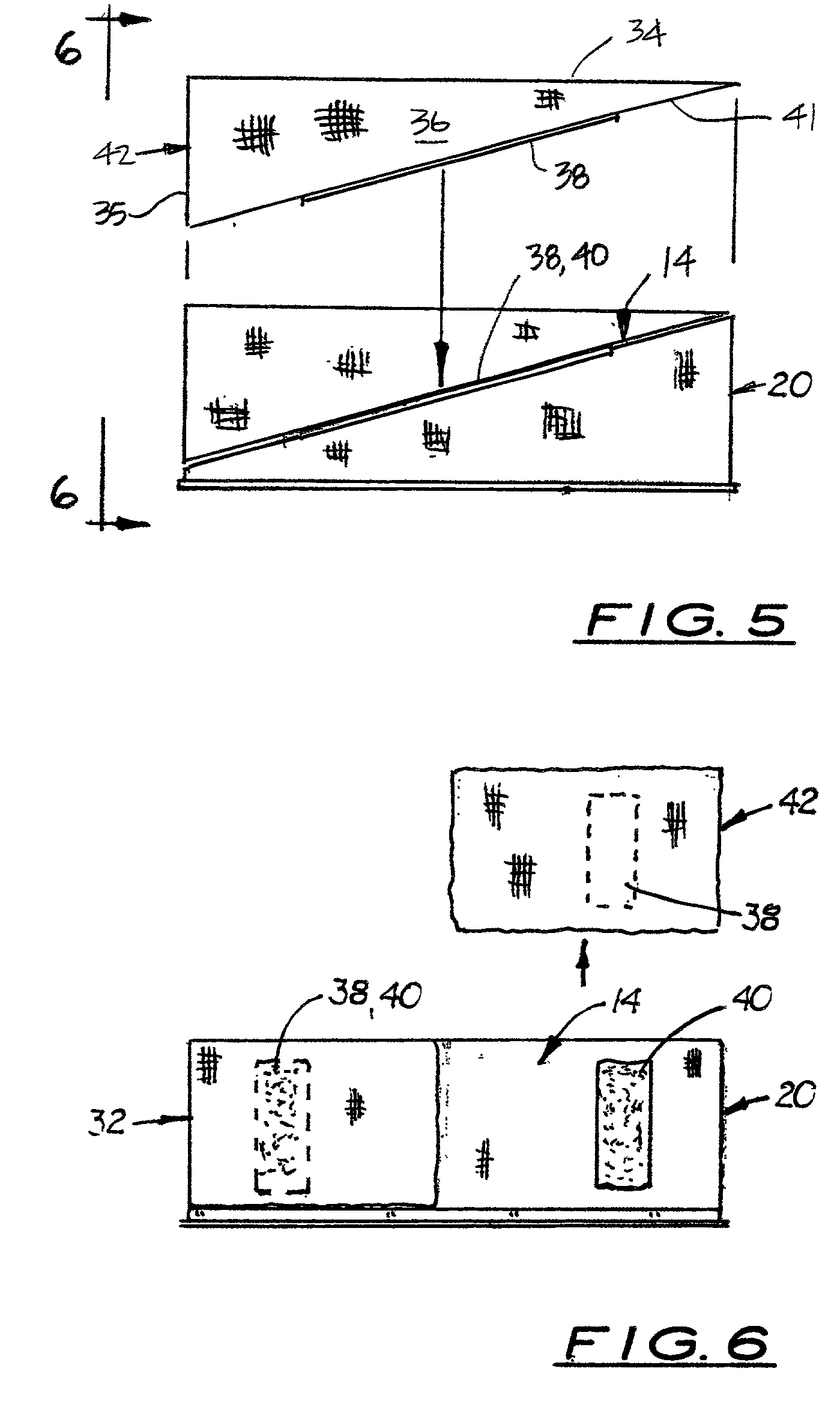Adjustable split seat
a split seat and adjustable technology, applied in the field of adjustable seats, can solve the problems of preventing adequate leg movement, affecting the comfort of patients, and affecting the comfort of patients, and conventional chairs do not have the means to accommodate these needs
- Summary
- Abstract
- Description
- Claims
- Application Information
AI Technical Summary
Benefits of technology
Problems solved by technology
Method used
Image
Examples
first embodiment
[0034] Shown in the accompanying FIGS. 1-9, there is shown an adjustable split seat 10 designed to allow a hip replacement patient 80 to sit comfortably with a reduced hip flexion. Using the split seat 10 with one knee flexed and with the wedge-shaped seat section 42 removed, there is limited thigh contact with the seat 85 and the blood flow through the lower leg 82 is less restricted and the tissue pressure is reduced, as shown in FIG. 3. FIG. 1 shows the split seat 10 before it is placed in position on a conventional chair 90. As shown more clearly in FIG. 4, the split seat 10 includes a main support body 20 made of a firm, yet flexible material, such as foam. In the preferred embodiment, for additional support and comfort, a rigid base layer 19 is registered and attached to the lower surface 11 of the main support body 20 so that the bottom surface 15 on the rigid base layer 19 makes contact with the seat 85. The main support body 20 includes a flat, horizontally aligned lower su...
second embodiment
[0041] FIGS. 7-10 show the seat 10' where the elastic wedge-shaped seat sections 32, 42 are replaced with two inflatable wedge-shaped seat sections 27, 37 disposed over a main support body 20. Each inflatable wedge-shaped seat section 27, 37 includes an inner bladder 29, 39 connected to an air inlet conduit 70. The inner bladders 29, 39 are inflatable units made of plastic, vinyl, or other material conducive to containing air in a flexible container. Each air inlet conduit 70 is connected to a switch 75 used to activate a pump 78 and to control the direction of air to and from one of the air bladders 29, 39. In the preferred embodiment, the switch 75 is a four-way switch that enables the user to choose one of four positions to perform the following: 1) inflate right elastic wedge-shaped seat section 27, 2) deflate right elastic wedge-shaped seat section 27, 3) inflate left elastic wedge-shaped seat section 37, and 4) deflate left elastic wedge shaped seat section 37. In another embo...
third embodiment
[0042] Shown in the accompanying FIGS. 11-16 is the split seat 10" also designed to allow the user 80 to comfortably sit with at least one leg substantially aligned with the back. Using the split seat 10" with the knee flexed and with limited thigh contact with the seat, the blood flow through the lower leg 90 is less restricted. With the thigh resting on the lowered seat, the hip flexion is also reduced.
[0043] In the preferred embodiment, the seat 10" includes a lower seat component 112 with back support 120. The seat component 112 includes two seat sections 114, 116 that pivot around the seat's rear transverse axis 130. Each seat section 114, 116 may pivot approximately 35.degree. thereby relieving pressure on the back of the thigh and buttocks allowing improved blood flow in the leg. When the seat section 114 or 116 supporting the leg 90 is slanted downward and the back support 120 is rotated rearward, the user's lower leg 190 may be straightened in alignment with the user's back...
PUM
 Login to View More
Login to View More Abstract
Description
Claims
Application Information
 Login to View More
Login to View More - R&D
- Intellectual Property
- Life Sciences
- Materials
- Tech Scout
- Unparalleled Data Quality
- Higher Quality Content
- 60% Fewer Hallucinations
Browse by: Latest US Patents, China's latest patents, Technical Efficacy Thesaurus, Application Domain, Technology Topic, Popular Technical Reports.
© 2025 PatSnap. All rights reserved.Legal|Privacy policy|Modern Slavery Act Transparency Statement|Sitemap|About US| Contact US: help@patsnap.com



